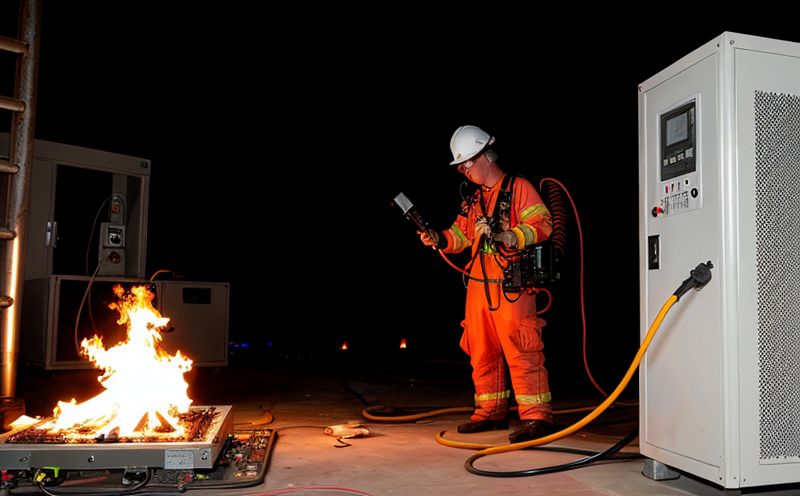Fire Resistance Testing of Electrical Panels
In today’s world, where electrical and electronic equipment are integral to our daily lives, ensuring their safety is paramount. This includes not only the devices themselves but also the panels that house them. Fire resistance testing for electrical panels plays a critical role in safeguarding infrastructure against potential fire hazards. The primary aim of this test is to evaluate the ability of an electrical panel to withstand exposure to flames without compromising its structural integrity or causing a spread of fire.
The standards such as ISO 6942 and ASTM E119 provide guidelines on how these tests should be conducted. These standards ensure that the testing process is consistent, replicable, and reliable across different laboratories worldwide. Electrical panels are exposed to controlled flame impingement for a specified duration. The test measures various parameters including structural integrity, smoke production, heat release rates, and flame spread.
The importance of fire resistance testing cannot be overstated, especially in high-risk environments such as data centers, hospitals, and industrial facilities where the failure of an electrical panel could lead to catastrophic consequences. By subjecting panels to rigorous testing, we can ensure that they meet or exceed regulatory requirements set forth by authorities like Underwriters Laboratories (UL) and Canadian Standards Association (CSA).
The process typically involves several stages. First, the specimen is prepared according to specified dimensions and configurations relevant to its intended use. Then, it undergoes a series of thermal exposures designed to simulate real-world conditions under which electrical panels might be exposed to fire.
Upon completion of the test, detailed reports are generated summarizing all observations made during each stage. These reports serve as valuable tools for manufacturers and designers in refining their products further while also providing assurance to end-users about compliance with relevant safety regulations.
| Parameter | Description |
|---|---|
| Flame Spread Index (FSI) | A measure of how much a flame spreads over the surface area exposed to it. Lower values indicate better performance. |
| Smoke Production Index (SPI) | An indicator of the amount of toxic gases produced when the specimen burns. Lower SPI means less harmful emissions during combustion. |
| Thermal Conductivity | The rate at which heat flows through the material. Higher thermal conductivity indicates faster heat dissipation, reducing risk of overheating. |
Understanding these parameters helps stakeholders make informed decisions regarding product design and selection. For instance, specifying panels with lower FSI and SPI values ensures safer operation even in challenging environments.
This testing is crucial for ensuring not only compliance but also enhancing the overall safety profile of buildings equipped with these critical components. It contributes significantly towards minimizing risks associated with electrical fires which can have severe impacts on human life, property damage, and environmental health.
Why It Matters
The significance of fire resistance testing extends beyond mere compliance; it directly impacts public safety and business continuity. Electrical panels are often located in areas where they may come into contact with flammable materials or be exposed to electrical arcs that could ignite fires.
- Public Safety: In residential buildings, schools, and healthcare facilities, electrical panels form part of the building’s fire protection strategy. Ensuring these components can withstand ignition sources reduces the likelihood of cascading failures leading to larger-scale disasters.
- Environmental Impact: Fires originating from electrical panels release pollutants into the atmosphere, contributing to air quality degradation. Tests that confirm compliance with stringent emissions limits help mitigate this issue by encouraging manufacturers to produce cleaner burning products.
- Economic Benefits: Reliable infrastructure built using high-quality tested materials saves money in terms of insurance premiums and maintenance costs over time. Additionally, avoiding costly downtime due to catastrophic failures translates into significant savings for businesses operating critical facilities.
In summary, investing in thorough fire resistance testing demonstrates a commitment to safety and sustainability that benefits everyone involved—from manufacturers producing the equipment to end-users who rely on it daily.
Scope and Methodology
| Methodological Steps | Description |
|---|---|
| Preparation: | The electrical panel is prepared according to the dimensions specified in the test protocol. This includes ensuring all components are assembled correctly and securely. |
| Exposure: | The panel is exposed to a controlled flame source for a predetermined period, typically ranging from 15 minutes up to several hours depending on its intended use and the specific standard being followed. |
| Data Collection: | Throughout exposure, various parameters such as temperature changes, smoke generation, and structural integrity are continuously monitored using advanced instrumentation. |
| Evaluation: | Post-test evaluation involves assessing whether the panel met all specified criteria outlined in relevant international standards like ISO 6942 or ASTM E119. Compliance is determined based on predefined thresholds for each parameter measured during testing. |
The methodology ensures that every aspect of a given electrical panel’s performance under fire conditions is thoroughly examined, providing comprehensive insights into its suitability for various applications.
Why Choose This Test
- Regulatory Compliance: Meeting stringent fire safety regulations such as those enforced by UL and CSA ensures that your products meet industry standards.
- Enhanced Reputation: Demonstrating commitment to quality through rigorous testing enhances your brand's reputation among consumers and stakeholders alike.
- Risk Reduction: By identifying potential weaknesses early on, you reduce the risk of costly recalls or product liability lawsuits down the line.
- Innovation: Testing provides feedback that can be used to improve existing designs or develop new ones tailored specifically for enhanced fire safety performance.
- Customer Confidence: Showing due diligence in testing builds trust with customers who are more likely to choose reliable products over untested alternatives.
- Competitive Advantage: Offering superior fire resistance features differentiates your products from competitors, attracting discerning buyers seeking premium quality and performance.
The benefits extend far beyond mere compliance; they contribute to creating safer environments for all users of electrical panels. This competitive edge can translate into increased market share and higher customer satisfaction levels.





